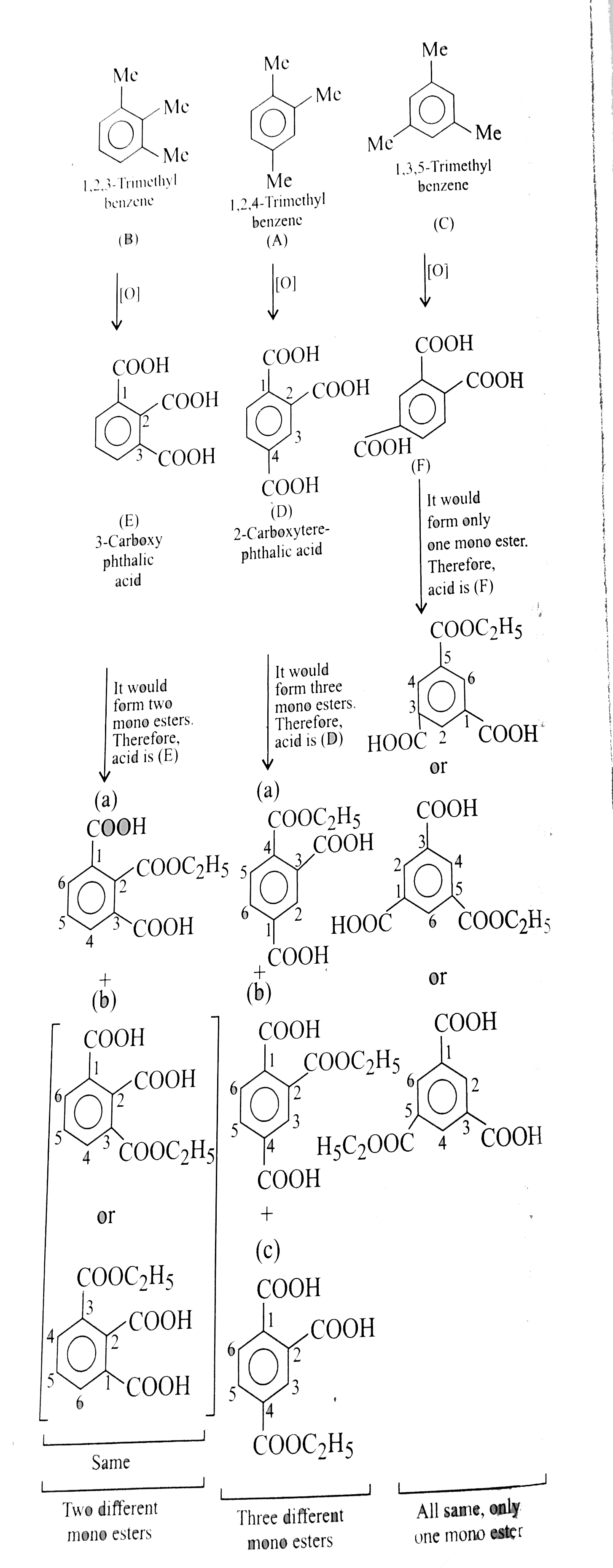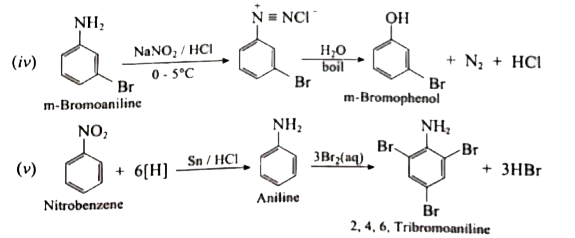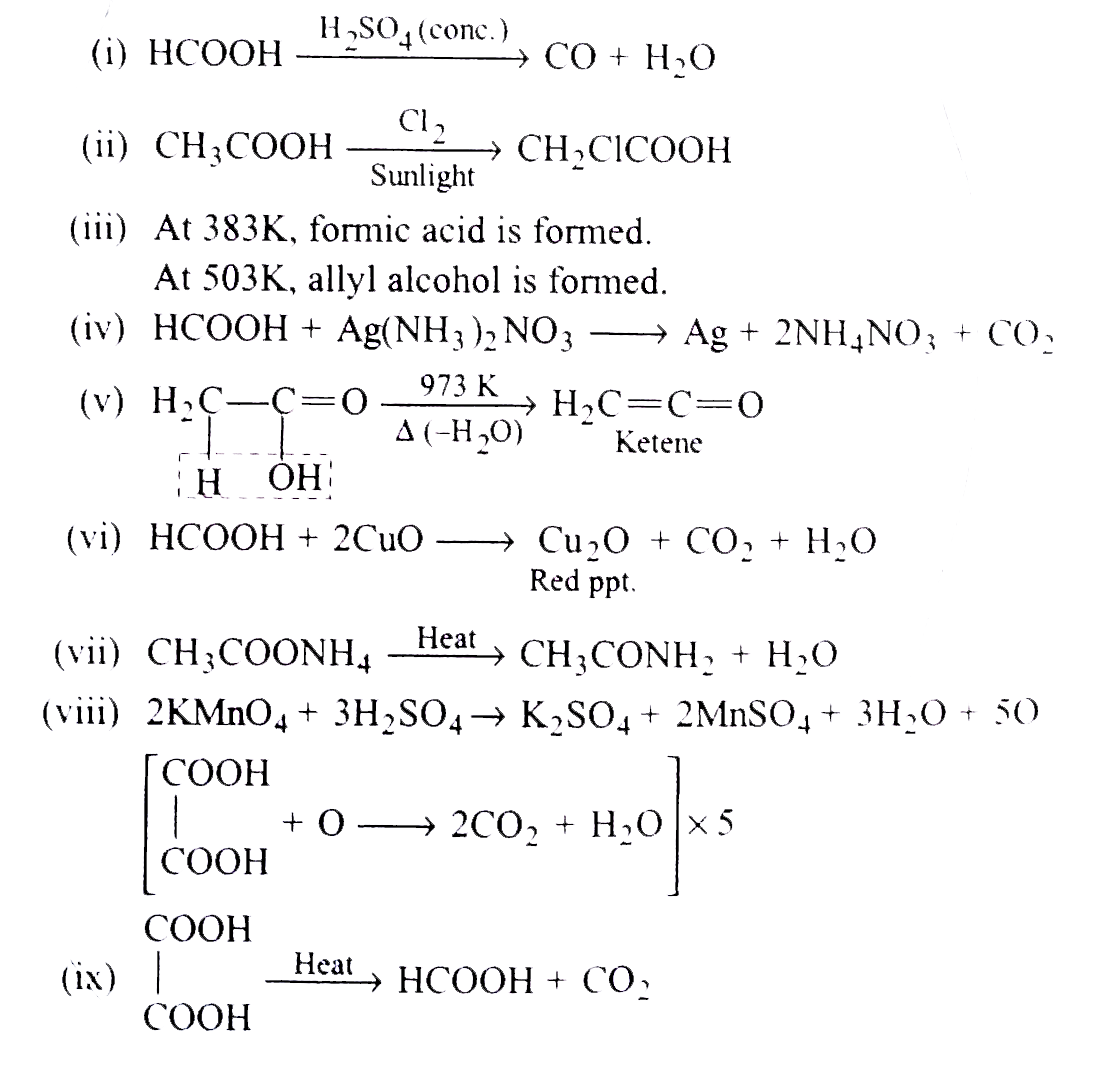InterviewSolution
This section includes InterviewSolutions, each offering curated multiple-choice questions to sharpen your knowledge and support exam preparation. Choose a topic below to get started.
| 7151. |
Which is larger, an He^(+) ion with an electron in an orbit with n=3 or an Li^(2+) ion with an electron in an orbit with n=5? |
|
Answer» `He^(+)` |
|
| 7152. |
Which one of the following is nearest to the nucleus? |
|
Answer» 6S |
|
| 7154. |
What are detergents? How are they classified? Why are detergents preferred over soaps? |
|
Answer» Solution :Detergents are sulphonate or hydrogen sulphate SALTS of long chain hydrocarbons containing 12-18 CARBON atoms. Types of detergents (i) CATIONIC detergents (ii) Anionic detergents (iii) Non-ionic detergents Advantages of detergents over soaps: UNLIKE soaps they work well EVEN with hard water. They can work well even in acidic water. They are more effective than soaps. |
|
| 7155. |
Which of the following nitro-compounds behave as an scid in the presence of strong alkaki? |
|
Answer» Primary |
|
| 7156. |
Which of the following has open book-structure |
|
Answer» `SCl_(2)` |
|
| 7157. |
Write the products obtained when benzyl phenylether is heated with HI. |
| Answer» SOLUTION :PHENOL and BENZYL IODIDE. | |
| 7158. |
Three isomeric hydrocationsC_(9) H_(12) [(A),(B),(C)] oxide to C_(9) H_(6)O_(6) [(D),(E),(F)] while(D) may give three different monoethyl esters, (E) may fromonly two and (F) only one. Idenity compounds (A) to (F). |
|
Answer» Solution :`D.U` in `C_99) H_(12) = ((2n_(C) + 2)-n_(H))/(2)` `= ((2xx9+2)-12)/(2) = 4^(@)` `4 D.U` suggets that it contains benzene ring. On OXIDIATION `(A),(B)`, `(C)` give `C_(9) H_(6)O_(6)`, whicvh suggests three `(COOH)` groups. Therefore `(A), (B), (C)` contain three `(Me)` groups whicvh on oxidation give three `(COOH)` groups. The three isomers of `C_(9) H_(12)` are: 
|
|
| 7159. |
Which compaounds are aromatic? For any compound that is not aromatic, state why this is so. |
|
Answer» |
|
| 7160. |
Whichofthefollowingis thestrongestbase ? |
|
Answer» ` C_ 6H_ 5 NH _ 2` |
|
| 7161. |
The velocity of an electron in Bohr's first orbital of la H-atom is 2.16xx10^(6)ms^(-1). Its velocity in the second orbit would be |
|
Answer» `1.08xx10^(6)MS^(-1)` `(v_(2))/(v_(1))=(n_(1))/(n_(2))` `:.v_(2)=v_(1)xx(n_(1))/(n_(2))=2.16xx10^(2)xx1/2` `=1.08xx10^(5)ms^(-1)` |
|
| 7162. |
What happens when (i) a pressure greater than the osmotic pressure is applied on the solution side separated from solvent by a semipermeable membrane ? (ii) acetone is added to pure ethanol ? |
|
Answer» Solution :(i) Solvent from the solution will move towards the solvent compartment. This is called reverse osmosis. (II) In PURE ethanol, molecules are hydrogen bonded. On ADDING acetone, its molecules get in between the host molecules and BREAK some of the hydrogen bonds between them. Due to WEAKENING of interactions, the solution shows positive deviation from Raoult.s law. |
|
| 7163. |
Write the chemical equations involved in the preparation of elemental boron from mineral colemanite. |
|
Answer» SOLUTION :`Ca_(2)B_(6)O_(11)+4SO_(2)+11H_(2)Oto2Ca(HSO_(3))_(2)+6H_(3)BO_(3)` `2H_(3)BO_(3)overset(Delta)toB_(2)O_(3)+3H_(2)O, B_(2)O_(3)+2AL to Al_(2)O_(3)+2B` |
|
| 7164. |
When an electric cell is charged then |
|
Answer» VOLTAGE of cell increases |
|
| 7165. |
Write the IUPAC name of K_(2)[Zn(OH)_(4)]. |
|
Answer» Solution :`k_(2)[ZU(OH)_(2)]` IUPAC NAME : POTASSIUM dihydroxozincate (II) |
|
| 7166. |
What is the maximum volume of water required to dissolve 1g of CaSO_(4) at 298 K, K_(sp)(CaSO_(4))=9.1xx10^(-6). |
|
Answer» 5.0 L |
|
| 7167. |
Write one similarity and one difference between the chemistry of lanthanoids and that of actinoids. |
|
Answer» Solution :Similarity : Both are inner TRANSITION ELEMENTS i.e., electrons are being filled in second LAST shell. Difference : Actinoid contraction from ELEMENT to element is GREATER than lanthanoid contraction. |
|
| 7169. |
Which of the following is not correctly matched |
|
Answer» `{:("COMPOUND" ,,,,"Use"),((1)"Ethanoic acid" ,,,,"Solvent"):}` |
|
| 7170. |
Whichof the following elements is present as impurity to the maximum extent in the pig iron? |
|
Answer» Manganese |
|
| 7171. |
Two Daniel cells contain the same solution of ZnSO_4 but differ in the CuSO_4 solution. The emf of the cell containing 0.5 M CuSO_4 is higher than the other cell by 0.06V. Calculate the concentration of CuSO_4 in the other cell. |
|
Answer» |
|
| 7172. |
The unit of ebulioscopic constant is ……. |
|
Answer» K kg `MOL^(-1)` or K `("MOLALITY")^(-1)` `K_(b)=(Delta T_(b))/(m)=(K)/("Molality")=(K)/(mol kh^(-1))="K kg mol"^(-1)`. |
|
| 7173. |
What happens when a mixture of acetylene and hydrogen is passed over heated Lindlar's catalyst |
|
Answer» ETHANE and water are formed |
|
| 7174. |
Which mechainsm is not seen during the hydrolysis of ester ? |
|
Answer» `A_(AC^(2))` |
|
| 7175. |
Which one of the following conclusions could not be derived from Rtherford's alpha- particle scattering experiments? |
|
Answer» Most of the space in the ATOM is empty. |
|
| 7176. |
Which of the following is not antibiotic ? |
|
Answer» Tetracylin |
|
| 7177. |
The salt on heating does not give brown coloured gas is: |
|
Answer» `LiNO_3` |
|
| 7178. |
The vapour pressure of solution of 5 g of acetic acid in 100 g of water at 25^(@)C was 23.40 torr and of the same mass of acetic acid in 100 g of benzene war 70 torr. Assuming acetic acid to be non-volatile, find out its physical state in the two solution, Given P_(H_2)^(@)o=23.756 and P_(C_6H_(6))^(@)=72.5 "torr at"25^(@)C. |
|
Answer» (a) in water solution. `(P_(H_(2)O)^(@)-P_(S))/P_(S)=(eta_(CH_(3)COOH))/(eta_(H_(2)O))` `P_(H_(2)O)^(@)=23.756" TORR", P_(S)=23" torr", eta_(CH_(3)COOH)=(5g)//m_(CH_(3)COOH),` `eta_(H_(2)O)=((100g))/((18"g mol"^(-1)))=100/18mol` `((23.756-23.4)"torr")/(23.4"torr")=((5g))/(M_(B))XX((18"mol"^(-1)))/(100),M_(B)=(23xx(5g)xx(18"mol"^(-1)))/(0.356xx100)=59.16" g mol"^(-1)`. (b) In banzene solution. `P_(C_(6)H_(6))^(@)=72.5" torr", P_(S)=70"torr", n_(CH_(3)COOH)=(5g)//m_(CH_(3)COOH),` `n_(C_(6)H_(6))=((100g))/((78"g mol"^(-1)))=((100)/(78)mol),((72.5-70)"torr")/(70"torr")=((5g))/M_(B)xx(78"mol"^(-1))/100` `M_(B)=(70.0)/(2.5)xx(5xx78("g mol"^(-1)))/100=109" g mol"^(-1)` (c) Predicting physical state of acetic ACID in the two solutions. `"Normal molar mass of "CH_(3)COOH=60" g mol"^(-1)` `"Observed molar mass in water "=59.16" g mol"^(-1)` `"Observed molar mass in benzene "= 109.2" g mol"^(-1)` The value clearly show that acetic acid remains as monomer in water and DIMER in benzene because of intermolecular hydrogen bonding. 
|
|
| 7179. |
Which of the following is not a method of concentration of Ores? |
|
Answer» Froth floatation |
|
| 7180. |
Write structures of the products of the following reactions : |
Answer» SOLUTION :
|
|
| 7181. |
Write reactions and conditions required for the following conversion: (i) Aniline to benzne (ii) Methylamine to methylcyanide (iii) Propanenitrile to ethylamine (iv) m-Bromoaniline to m-bromophenol (v) Nitrobenzene to 2,4,6- tribromoaniline. |
Answer» SOLUTION : (II) `underset("Methylamine")(CH_(3)NH_(2))overset(HNO_(2))(to)CH_(3)OH overset(PCl_(5))(to)CH_(3)Cl overset(KCN)(to) underset("Methyl cyanide.)(CH_(3)C-=N` (iii) `underset("Propanenitrile")(CH_(3)CH_(2)C-=N)+H_(2)O underset(H_(2)O_(2))overset(OH^(-))(to) underset("Propanamide")(CH_(3)CH_(2)-overset(O)overset(||)(C)-NH_(2))underset(KOH) overset(Br_(2))(to) underset("ETHANAMINE")(CH_(3)CH_(2)NH_(2))` 
|
|
| 7182. |
Which of the following compounds is coloured |
|
Answer» `TiCl_(3)` `Ti^(3+) = [Ar]3d^(1) (` one unpaired electron ) in `FeCl_(3)` `Fe^(3+)= [Ar]3d^(5) (` Fiveunpaired electrons)in `CoCl_(2)` `Co^(2+) = [Ar]3d^(7)` ( Three unpaired electrons ) Hence, all compoundsare coloured. |
|
| 7184. |
Which of the following in not part of green chemistry? |
|
Answer» PHOTO CHEMISTRY |
|
| 7185. |
What will be the effect of temperature on the constant? |
|
Answer» SOLUTION :Rate constant of a reaction increases with the increase in temperature . In case of most homogeneousreactions , the value of rate constant increases by 2 to 3 times forevery `10^(@)C` rise in temperature . The exact dependence of the rate constant on temperature is given by Arrhenius equation, `K=Ae^(-E_(a)//RT)` ,where A is the frequency factor and `E_(a)` is activation energy of the reaction. As T increases,`E_(a)//RT` DECREASES and `E^(-E_(a)//RT)(=(1)/(e^(E_(a)//RT)))` increases and hence , the value of k increases . |
|
| 7186. |
Toluene is obtained by reaction of mixture of chlorobenzene and methyl chloride with Na metal in dry ether. This reaction is called …… |
|
Answer» Wurtz FITTING reaction |
|
| 7187. |
Which of the following can be used as monomer in polymerixation reaction |
|
Answer» `CH_(3)CH_(2)CI` |
|
| 7188. |
Total number of lone pair of electrons in XeOF_(4) is |
|
Answer» 0 |
|
| 7189. |
Tick the wrong statement : |
|
Answer» Amorphous solids are ISOTROPIC. |
|
| 7190. |
What is the initial product of the acidic hydrolysis of a cyanide |
|
Answer» A primary AMIDE |
|
| 7191. |
When Zn is added to CuSO_(4) solution , copper is precipitated because of : |
|
Answer» reduction of Zn |
|
| 7192. |
Which of the following statements is incorrect for Be? |
|
Answer» Most of its compounds are largely covalent |
|
| 7193. |
What is water gas equilibrium ? |
|
Answer» Solution :The equilibrium involved in the reaction between carbon dioxide and hydrogen, has MANY industrial applications and is called WATER GAS equilibrium. `CO_(2)+H_(2)tounderset(("water gas"))(CO+H_(2)O)` |
|
| 7194. |
Which is not an example of gaseous air pollutants ? |
|
Answer» OXIDES of halogens |
|
| 7195. |
When an orange coloured crystallccompound [A] was heated withcommon salt and concentrated sulphuricacid , an orange red colouredgas [B] wasevolved. The gas [B] on passingthrough NaOH solution gave a yellow solution [C] . Thesolutionon reactingwith an aqueous solution of lead acetate gave a yellow precipitate. The yellow solution [C] containsmainly |
|
Answer» Sodium sulphate `CrO_(2)Cl_(2)+4NaOH to underset("(yellow solution)")(Na_(2)CrO_(4))+2NaCl+2H_(2)O` |
|
| 7196. |
When an orange coloured crystallccompound [A] was heated withcommon salt and concentrated sulphuricacid , an orange red colouredgas [B] wasevolved. The gas [B] on passingthrough NaOH solution gave a yellow solution [C] . Thesolutionon reactingwith an aqueous solution of lead acetate gave a yellow precipitate. The crystalline compound [A] is: |
|
Answer» COBALT nitrate |
|
| 7197. |
When an orange coloured crystallccompound [A] was heated withcommon salt and concentrated sulphuricacid , an orange red colouredgas [B] wasevolved. The gas [B] on passingthrough NaOH solution gave a yellow solution [C] . Thesolutionon reactingwith an aqueous solution of lead acetate gave a yellow precipitate. This gas [B] is : |
|
Answer» Chlorine |
|
| 7198. |
Which one of the following relationship is correct ? |
|
Answer» `PH=(1)/([H^+])` |
|
| 7199. |
Whilch of these is not a monomer for a high molecular mass silicone polymer? |
|
Answer» `Me_(3)SICL` |
|
| 7200. |
What happens when? (i) Formic acid is heated with conc. H_(2)SO_(4) (i) Dry chlorine is passed through acetic acid in presenece of sunlight (iii) Oxalic acid is heated with glycerol. (iv) Formic acid is reacted with ammoniacal silver nitrate solution Glacial acetic acid is heated at 973 K (vi) Formic acid is heated with Fehling's solution (vii) Ammonium acetate is dry distilled. (viii) Acidified potassium permanganate is added to oxalic acid (ix) Oxalic acid is heated. (x) Maleic acid is heated. (xi) A carboxylic acid is treated with lithium aluminium hydride. (xii) Acetic acid reacts with thionyl chloride. (xiii) Tartaric acid is treated with hydrogen iodide. (xiv) Lactic acid is heated. (xv) Citric acid is refluxed with hydriodic acid. |
Answer» SOLUTION : 
|
|